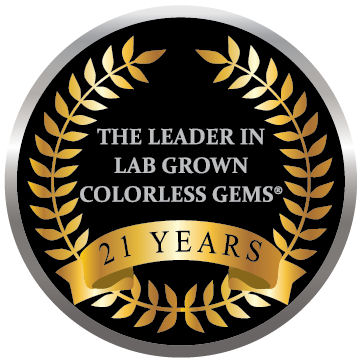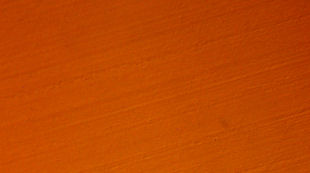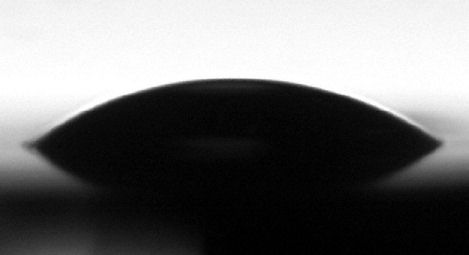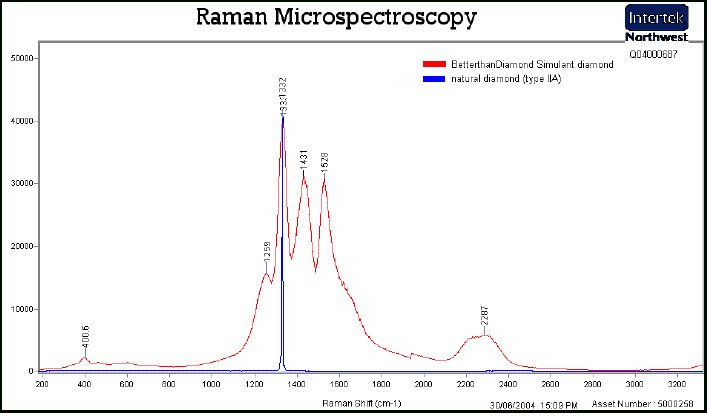- Home
- Asha Diamond Simulants
- Asha Product Testing
Categories
- Amora Gem
- Takara Lab Grown Diamonds
- Overnight Earrings
- Asha® Diamond Simulant
- Rings
- Earrings
- Bands
- Forever Brilliant Moissanite - Certified
- Moissanite
- Asha® Dangle Earrings
- Asha® Stud Earrings
- Pendants
- Avarra Lab Grown Rubies
- Avarra Lab Grown Alexandrite
- Avarra Lab Grown Colombian Emeralds
- Avarra Lab Grown Sapphire
- Amethyst (Natural Bolivian)
- Miscellaneous
Popular Brands
Our Newsletter
Asha Product Testing
Asha Simulated Diamond, Independent Testing results
Asha in the lab...prepping for the amorphous diamond infusion process.Version 6 Asha Simulated Diamond Testing:
Test 1: Raman spectroscopy by Evans Analytical Group
Excerpted from Report
(Important Note: sp3 means Diamond Bonds; sp2 means graphite bonds):
Purpose:
To detect the presence of a diamond like carbon (DLC) coating on a zirconia gem.
Summary:
DLC was detected by Raman spectroscopy on the gem coating. The DLC was of high quality, having probably up to 85% sp3 content, typical for a tetrahedral amorphous carbon.
Experimental:
The Raman measurements were performed with a “Dilor” J-Y spectrometer (“LabRam”) equipped with a “BX40 Olympus” microscope using the backscattering geometry (1800). A HeNe laser (632.8 nm wavelength) and a 600 gr/mm grating were used in these measurements, which were repeated with an Ar+ ion laser (514.5 nm wavelength) and an 1800 gr/mm grating.The full report is available in PDF format for viewing here:
https://betterthandiamond.com/reports/EvansAnalytical_raman.pdf
Notes: The sample submitted was an H/I color.
Gemologist with access to Raman who would like to independently reproduce this testing should feel free to contact us to arrange for test samples with various thickness of amorphous diamond coating (color set) as differing Raman systems have varying sensitivity.
Version 5 testing:
Version 5 Testing - Asha Fake Diamond:
We have sent our Asha version 5 to three different independent testing labs to show the results of our amorphous diamond infusion process. We are pleased to show the results below:
The three tests run were:
1)X-Ray Photoelectron Spectroscopy (XPS).
2)Contact Angle Goniometry
3)Raman microspectroscopy
Test 1: X-Ray Photoelectron Spectroscopy (XPS)
Purpose: To verify the elemental (surface) composition of the Asha Diamond Simulant
Results: "The principal element found at the surface is carbon".Summary:
The principal element found at the surface is carbon. As would be expected, considerable surface oxygen was also measured.
An atomic concentration of zirconium of 3.1 atomic % was found in the surface of the coating
[note: they indicated that during the coating/infusion process, some of the zirconium is being knocked into the mix].
The elemental concentrations in atomic % of the surface of the DLC coated Asha diamond simulant after the removal of surface debris with ultrasonic cleaning are:
Elements Asha Diamond Simulant Surface C (Carbon) 77.07% O (Oxygen) 17.09% Zr (Zirconium) 3.14% At concentrations below 1 atomic % N(0.71%), Y(0.61%), Si(0.53%), F(0.42%), Cl(0.31%), and Mg(0.11%) were detected in the coating.
Nomarski contrast image (tinted) of the Asha surface
taken prior to XPS testing
Test performed by: Anderson Materials Evaluation Laboratories (April, 2007)
Equipment used: "The surface of the coated Asha diamond simulant after ultrasonic cleaning was examined with XPS using a monochromatic aluminum X-ray source. The quantitative elemental concentration results were obtained from elemental survey spectra covering the binding energy range from 0 to 1100 eV with a step size of 0.5 eV and long 4 hour data acquisition time for improved accuracy".
Test 2: Contact angle goniometry
Purpose: To 'visually' show the amorphous diamond coating
Results: The Asha (version 5) with coating showed roughly 300% difference in contact angle as compared to an uncoated Asha core.
[Note: we have long known that the amorphous diamond coating helps keeps the Asha much cleaner, much longer than uncoated Asha or plain CZ as it has a coefficient of friction lower than teflon - this test helps show that effect.]Uncoated Asha, polished core - contact angle of 98.5 degrees:
Asha with amorphous diamond coating - contact angle of 31.7 degrees:
Test performed by: Future Digital Scientific Laboratories (March, 2007)
[Of interest, contact angle testing has been used to id authentic historical coins vs. otherwise undetectable fakes...because water contains billions of hydrogen atoms, it is very interactive and thus differing material surfaces will show varying contact angles even when other tests do not detect a difference.]
Test 3: Raman microspectroscopy
Purpose: To verify Asha contains diamond content
Results: The Asha (version 5) shows a diamond signature when run under Raman.
Test performed by: Intertek Northwest, NWTC Lab, England (July, 2004)
Equipment used: Confocal raman microscope with 785nm diode laser excitation
Comments: As you can see above, both the Asha and natural diamond exhibit a strong spike at nearly the same frequency - this is because both contain SP3 carbon (diamond bonds), and this spike is something no other diamond simulant can show, because no other diamond simulant has this level of diamond bonds integrated into its composition.
Raman testing is frequently done as a standard way to identify the composition of various gemstones, both natural and man-made, as it is relatively cheap to do, and is completely non-destructive. The Asha diamond simulant is the only diamond simulant in the world that employs a form of amorphous diamond pure enough to easily register under standard Raman microspectroscopy. This is why we note that Asha is the diamond worlds equivalent of the cultured pearl, because just as a pearl has an outer layer of nacre, the Asha employs an outer layer of amorphous man-made diamond.







